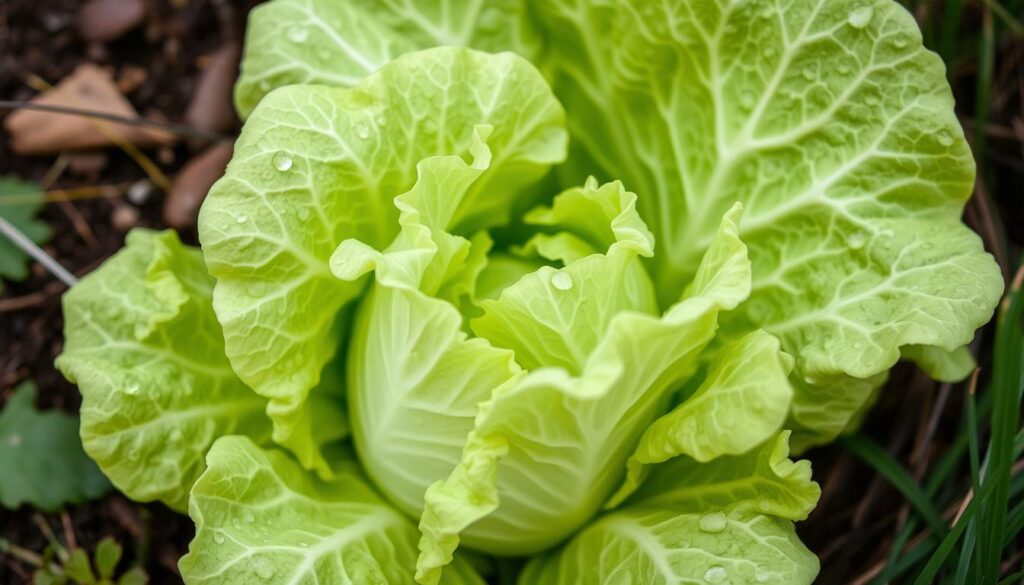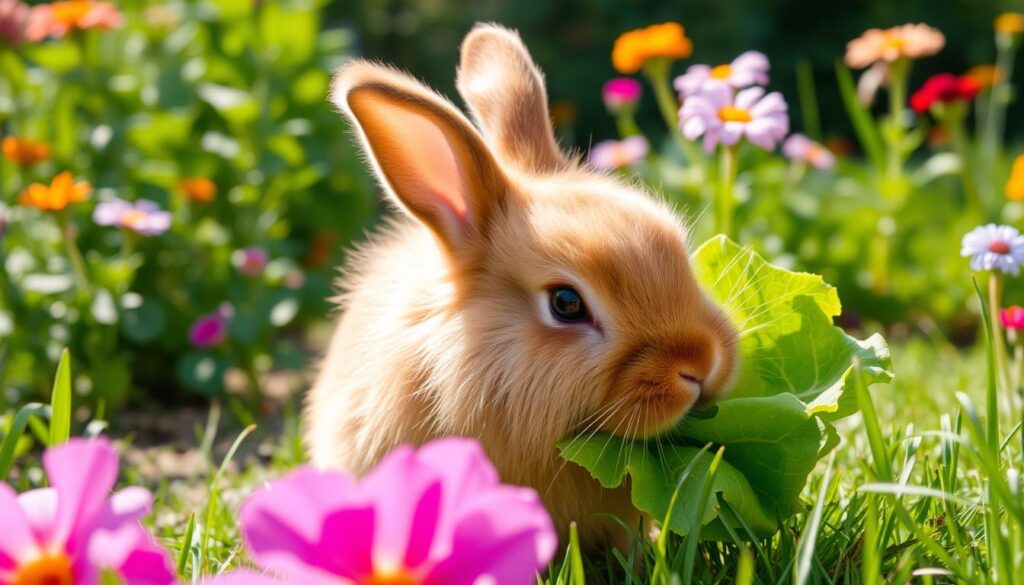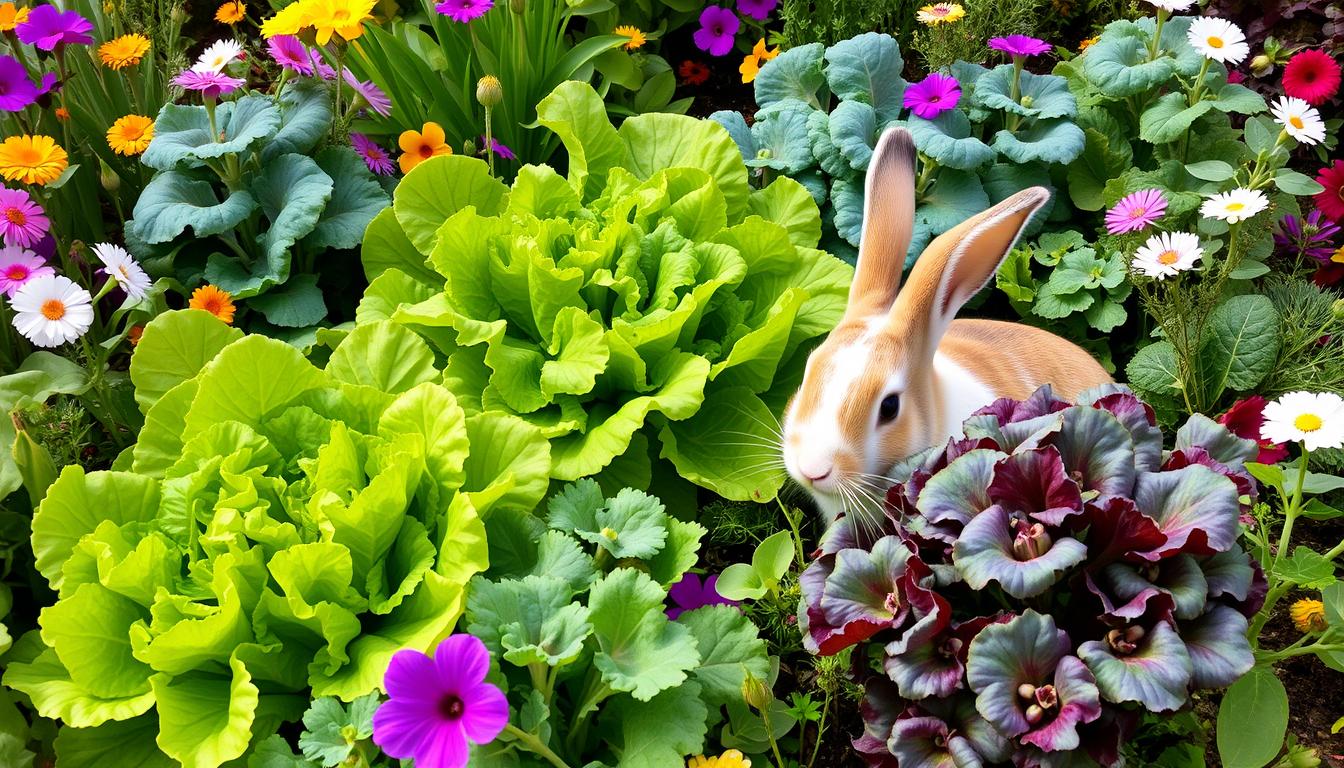Are you a rabbit owner wondering if your furry friend can enjoy lettuce? The answer might surprise you. Rabbits can eat lettuce, but there are some important things to know. This guide will help you understand which lettuces are safe and healthy for your pet bunny.
Table of Contents
Understanding the Basics of Rabbit Nutrition
It’s vital to give your rabbit a diet that’s both balanced and nutritious. They need 80-90% high-quality hay for their health. This hay is key for their digestion and teeth. Add fresh veggies, a bit of pellets, and always have water available.
The Importance of a Balanced Diet
Keeping your rabbit’s diet balanced is key. Hay should be the main part of their diet. It helps with digestion and keeps their teeth in check. Fresh veggies, making up 10% of their diet, give them vitamins, minerals, and fiber.
Key Nutritional Requirements
Rabbits have specific needs for a healthy life. They need hay, a bit of high-quality pellets, and fresh veggies. Start new foods slowly to prevent upset stomachs.
Role of Fresh Vegetables in Rabbit Diet
Fresh veggies are a big part of a rabbit’s diet. They’re packed with vitamins, minerals, and fiber. Choose leafy greens like romaine, kale, and spinach. A variety of veggies ensures a balanced diet.
| Nutrient | Importance for Rabbits |
|---|---|
| Fiber | Crucial for healthy digestion and preventing gastrointestinal issues. |
| Protein | Necessary for tissue growth and repair, as well as maintaining a healthy immune system. |
| Calcium | Supports strong bones and teeth, crucial for growing rabbits. |
| Vitamins A, C, and K | Promote eye health, immune function, and blood clotting, respectively. |
For your rabbit’s health, focus on hay, veggies, and a little pellets. This balanced diet is essential.
Can Rabbits Eat Lettuce: Safety and Guidelines
Rabbits can eat some types of lettuce safely. Look for dark, leafy greens like romaine, red leaf, and butterhead. These are full of fiber and nutrients that are good for them. But, stay away from iceberg lettuce because it’s not very nutritious and can upset their stomachs.
Start by adding lettuce slowly to your rabbit’s diet. Watch for any signs of tummy trouble. Always wash veggies well to get rid of harmful chemicals. Lettuce should only be a small part of their diet, about 10%. Make sure they also get plenty of hay, fresh veggies, and a little bit of pellets.
- Opt for dark, leafy lettuces like romaine, red leaf, and butterhead for their high fiber and nutrient content.
- Avoid iceberg lettuce, as it lacks nutritional value and can cause digestive issues.
- Introduce lettuce gradually, observing for any signs of digestive distress.
- Thoroughly wash all vegetables to remove any pesticides or chemicals.
- Lettuce should make up no more than 10% of your rabbit’s daily diet.
By following these guidelines, you can add lettuce to your rabbit’s diet safely. It will give them a nutritious and fiber-rich treat.
“Hay is considered the safest food for rabbits, with a top-quality hay being a main component of their diet.”
Different Types of Lettuce for Rabbits
Feeding your rabbit a healthy diet is important. Lettuce can be a great addition. But, not all lettuce is the same. Knowing the different types and their nutrients is key to your rabbit’s health.
Safe Lettuce Varieties
Rabbits can safely eat many types of lettuce. Here are some:
- Romaine lettuce
- Red leaf lettuce
- Green leaf lettuce
- Butterhead lettuce (such as Boston or bibb)
These leafy greens are full of nutrients, fiber, and water. They help keep your rabbit healthy. Romaine lettuce is especially good because it has more fiber and nutrients.
Varieties to Avoid
Some lettuce types are not good for rabbits. Iceberg lettuce is one to avoid. It has little nutrition and too much water. This can upset your rabbit’s stomach.
Nutritional Comparison
Different lettuces have different nutrients. Romaine lettuce has more vitamins, minerals, and antioxidants than iceberg lettuce. It’s better for rabbits because it offers more nutritional benefits.
When introducing new lettuce, do it slowly and in small amounts. This helps your rabbit’s stomach adjust. It also prevents any bad reactions.
The Truth About Iceberg Lettuce
Choosing the right lettuce for your pet bunny is key to their health. Some lettuces are safe and good for them, but iceberg lettuce is not. It’s high in water and low in nutrients.
Iceberg lettuce has too much water (95%) and not enough fiber or vitamins. This can cause digestive problems like diarrhea. It’s not good for your rabbit’s rabbit nutrition.
Iceberg lettuce also has a compound called lactucarium, which is like a natural opiate. Eating too much of it can be risky for your pet bunny. It’s safer to choose other lettuces like romaine or red leaf lettuce.
For a healthy diet, give your rabbit different greens. Kale, spinach, and parsley are good choices. They offer a balanced mix of nutrients.
“Iceberg lettuce may be tempting, but it’s simply not the best choice for your rabbit’s health and wellbeing. Stick to the more nutritious options to keep your bunny happy and healthy.”

Proper Portions and Feeding Schedule
Keeping your rabbit healthy is key. Feeding them right is important. They should eat mostly leafy greens, with a small amount of other veggies.
Daily Recommended Amounts
Give your rabbit a handful of fresh greens every day. This should be about 10% of their diet. Start new foods slowly, over 7-14 days, to help their stomach get used to it.
Best Times for Feeding
- Feed your rabbit fresh veggies in the morning and evening.
- This helps them eat like they do in the wild and keeps them healthy.
- Make sure they always have good hay to eat.
Signs of Overfeeding
Watch how much your rabbit eats and their poop. Look out for:
- Soft stools
- Not wanting to eat hay
- Gaining too much weight
If you see these signs, change their diet. If it gets worse, talk to a vet.
Health Benefits of Feeding Lettuce to Rabbits
As a responsible rabbit owner, you know how important a balanced diet is. Leafy greens like lettuce are key to your rabbit’s health. They add essential vitamins and minerals to their meals.
Dark, leafy lettuces, like romaine, are full of vitamins and minerals. They also have hydration, fiber, and antioxidants. These help your rabbit’s digestion, immune system, and overall health.
Lettuce is very hydrating, especially in warm weather. Its fiber helps with regular bowel movements. This prevents blockages, a common problem for rabbits.
Romaine lettuce is packed with vitamins A, K, and C, and minerals like calcium and iron. These nutrients support healthy vision, strong bones, and a strong immune system. They keep your rabbit healthy and active.
The fiber in lettuce also helps with dental health. As rabbits chew on the leaves, it wears down their teeth. This prevents dental problems.
“At the Rabitatas animal shelter, bunnies are typically fed a salad consisting of between 50-70% lettuce, as it provides essential hydration and fiber for their overall health.”
Adding the right lettuce to your rabbit’s diet ensures they get the nutrients they need. Start with small amounts and watch for any digestive issues. This helps them adjust smoothly and stay healthy.

Potential Risks and Warning Signs
Rabbits can get good nutrients from lettuce, but there are risks to watch out for. Eating too much lettuce, especially iceberg lettuce, can cause stomach problems. These include diarrhea, bloating, and a slowed digestive system.
Common Digestive Issues
Keep an eye on your rabbit’s eating habits, energy, and stool. If they have soft stools, eat less, or seem uncomfortable, it might be a sign of a problem. Changing their diet too fast can also upset their stomach. So, introduce new pet bunny food slowly.
When to Contact a Veterinarian
If you see any worrying signs, like those mentioned, call your rabbit’s vet fast. They can figure out what’s wrong and treat it. This way, your rabbit’s safe vegetables for rabbits diet and health stay on track.
When caring for your rabbit, it’s always safer to be careful. Paying close attention to their needs and acting quickly on any issues can keep them happy and healthy.
Safe Introduction of Lettuce to Your Rabbit’s Diet
When adding lettuce to your rabbit’s diet, start slow. Introduce it over 7 to 14 days. This lets their digestive system get used to it without problems. Begin with just a leaf or two and watch how they react.
If they do well with the first bit, you can add more. Offer different types of lettuce, like romaine and green leaf, for more nutrients. Always wash the lettuce well before giving it to your rabbit.
Keep giving them unlimited hay, as it’s key to their diet. Watch how much lettuce and other fruits and veggies you give. If they have digestive issues, like diarrhea or less appetite, stop the lettuce right away. Then, talk to your vet.


1 thought on “Can Rabbits Eat Lettuce: Your Complete Guide”